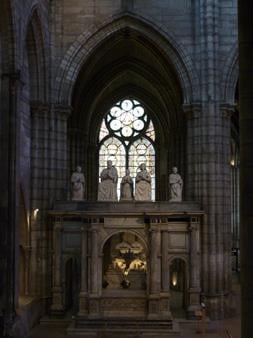
Thank you so much to Yann Kergourlay for writing this post on the Basilica of Saint Denis in Paris and for sharing these beautiful photographs. If you’re confused as to what this has to do with the Tudors, Mary Tudor, Queen of France, was crowned at St Denis, Anne Boleyn served Mary Tudor and Queen Claude, and Francis I was on the throne in France during Henry VIII’s reign (as was Louis XII). Over to Yann…
A crown upon your head….
The coronation wasn’t a necessary step for the Queen Consorts in France: a marriage with the King was enough to become Queen, since being Queen did not offer any real political role in the ruling of the realm. The coronation of a Queen was thus a rare and exceptional occasion.
The coronation of the Kings of France was almost always performed at the Cathedral of Reims whereas the coronation of a Queen was apparently either made at the Saint-Chapel or the Basilica of Saint Denis.
The two lavish coronations of Anne of Brittany in 1492 and 1504 undoubtedly set off the consideration of Saint Denis as the particular coronation place for all Queens of France. Many Queens after Anne were crowned at Saint-Denis: Mary Tudor ( November 5th, 1514), Claude of France ( May 10th, 1516) as well as Catherine of Medici (10th June 1549) up to Marie of Medici (13th May,1610) who is believed to be the last Queen to have been crowned at Saint-Denis.
Along with the coronation, the Queens made a magnificent entrance in Paris as well.
The coronation was of course different to that of the Kings. The anointment they received was not from the Holy Ampoule, the number of onctions was significantly lower and the Queen did not have any power over the population or over religion conferred upon her.
Apart from this special function as a place of coronation for Queens, the Basilica of Saint Denis sometimes held the coronation ornaments – It was either St Denis or Reims until Francis I created in 1530 the nucleus of crown jewels which was to be passed to each subsequent King upon their accession – and, most importantly, was the Necropolis of the Kings and Queens of France.
A crown upon your grave…
As the Necropolis of the Kings and Queens of France, the Basilica of St-Denis is filled with tombs and mausoleums which each tell a story. Yet there are three tombs that definitely catch the eye more than the others, as the term mausoleum would be better fitted for those: those of Anne of Brittany and Louis XII, Claude of France and Francis I, and Catherine of Medici and Henry II.
The Mausoleum of Anne of Brittany and Louis XII is widely considered to be one of the most beautiful in Saint Denis. Constructed by Francis I, it is the first mausoleum in the style of the Renaissance. It marks the beginning of the focus on the elaborateness of the tomb instead of the burying of some wealth and regalia in the tomb. Only two gilded copper crowns were placed on the grave. The mausoleum itself is made out of Marble of Carrare. It is a two-level Mausoleum in the form of a catafalque.
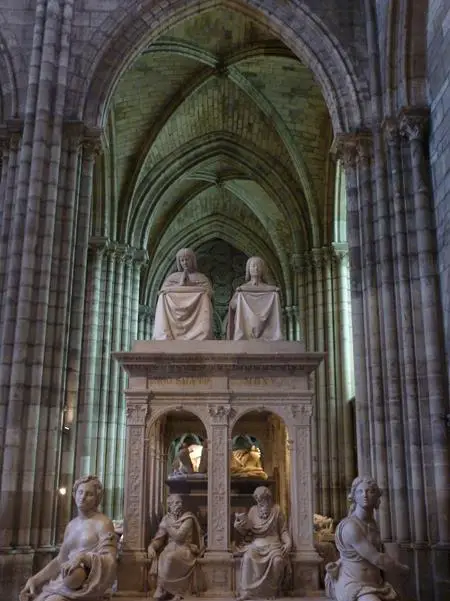
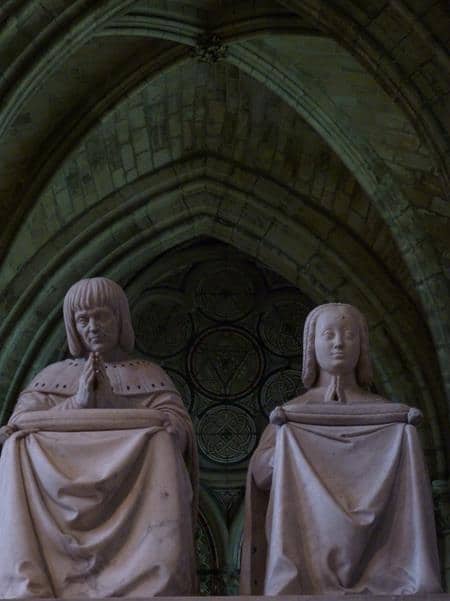
On top we can see the orants – praying figures- of Anne and Louis XII and beaneath the canopy, the gisants -lying down, recumbant figures. The gisants here do not represent Anne and Louis in full regalia, but naked and in their last breath. This “deathbed likeness” in marble was based on the waxwork made of their faces shortly after their death, which makes it surely the best indicator of their likeness. The body itself is surely mainly a construction not meant to represent the real physique of both, rather a generic body affected by a recent death which also in accordance to the ritual, shows the scar left by the opening of the body to take out the bowels (and in Anne’s case, her heart) and fill it with sweet-smelling ointments. The orants show Anne and Louis praying and the contrast between their expressions is striking: Anne is noble, almost haughty her stare into eternity seeming unshakeable, whereas Louis is more pensive, almost sad. Both are dressed regally but lack a crown or any regal symbol. Four statues stand – one at each angle – representing the virtues of Royalty: Strength, Temperateness, Prudence and Justice. Along with those, apostles are also represented. The identity of the makers of the mausoleum is not certain, although most believe it to be the Juste brothers.
The Mausoleum of Claude of France and Francis I follows the same pattern as Anne of Brittany and Louis XII’s. The orants represent from left to right: the Dauphin François, Francis I, Princess Charlotte, Claude of France and Charles of Orleans. Underneath the canopy, Claude and Francis are lying, naked in their last breath. If the two representations of Claude are to be believed to be acurate and faithful to what she looked like, it is hard to see how she lacked beauty, her features appearing to be symmetrical and delicate enough. As to Francis I, It seems clear that his nickname of “François au grand nez” (Francis of the large nose) was clearly deserved. The main difference between this mausoleum and that of Anne and Louis is to be found in the greater size and different details of it. It is particularly interesting to see how the “prie-dieu” of Anne and Louis lack any distinction or inscription whereas that of Claude notably bears a crowned C as her personal emblem. This mausoleum lacks the four statues of the virtues seen in Anne and Louis’. This mausoleum was commissioned by Henry II and made by several artists including Philibert de L’orme, François Camoy, François Marchand and Pierre Bontemps.
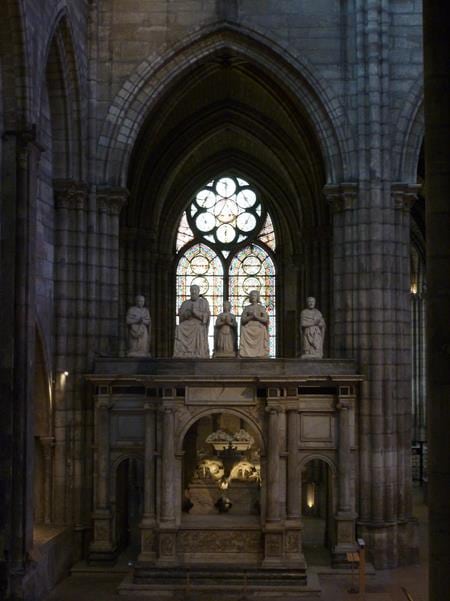
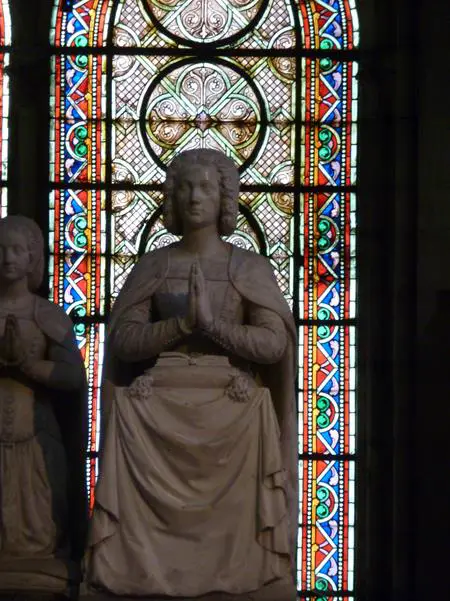
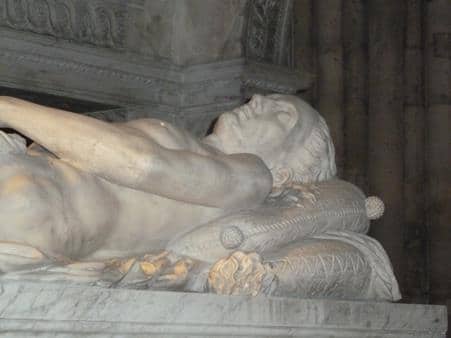
Henry II and Catherine of Medici’s mausoleum once again shares the same pattern as the two others, being the last of this kind to be seen in the Necropolis. The Mausoleum itself was meant for another building, the “Rotonde des Valois” where it stayed until 1719, the date of the destruction of the rotonde and the placement of the mausoleum in the Necropolis of St Denis. The mausoleum was meant, of course, to overshadow the others.
The distinctions between this one and the previous are most striking as the sculptor apparently wanted to create great contrast with black and white statues and ornaments. The black orants of Catherine and Henry, as well as the four statues of the virtues, are made out of bronze and have surprisingly survived to this day. The most startling thing about this Mausoleum is that it is actually accompanied in the Necropolis by another set of gisants in white marble representing Catherine and Henry in their coronation robes. Catherine’s likeness is particularly haunting, her features being just like those seen in most paintings of her. The eyes are open and the irises carved, which is quite unusual for a gisant but fitting for one representing them in the full regalia of their coronation. There is consequently a very impressive contrast between these coronation gisants and those underneath the canopy which represent them naked. Catherine of Medici is known to have commisionned this mausoleum and actually ordered the making of her gisant during her own lifetime, refusing the first one made by Della Robia, now in the Louvre. The actual gisant visible in St-Denis represents her in a peaceful death, her eyes slightly opened and her position often compared to that of a Florentine Venus. The Mausoleum was made by Germain Pilon.
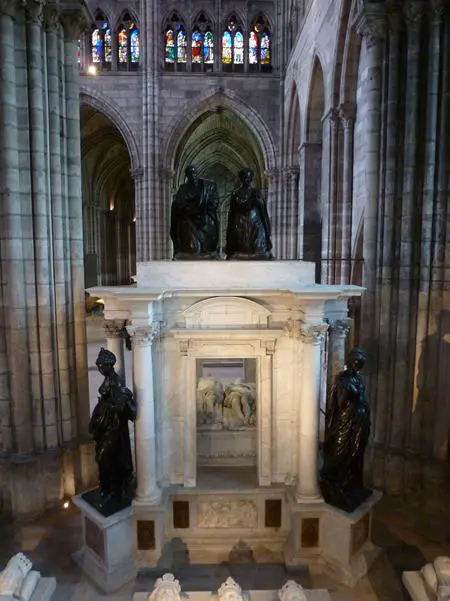
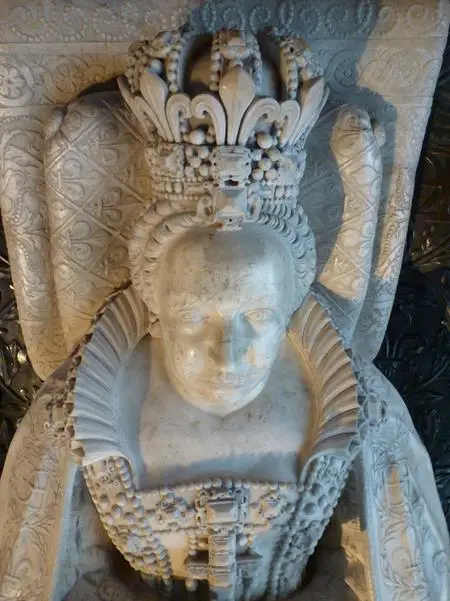
St Denis and the revolution: The irony of the Lackhead saint
Saint Denis’ distinctive feature when it comes to religious imagery is that he is always shown holding his severed head in his hands. The French Revolution infamously led to the decapitation of Louis XVI and Marie Antoinette, but also to the profanation of many churches, castles and any reminders of the Ancient Regime of Royalty.
The Basilica of St Denis was no exception. Already in 1792, the Basilica had seen many of its tombs being taken down because of one thing: metal. The revolutionary government had ordered the melting-down of all metal monuments and thus notably the monument of Charles VIII (fiancé to Margaret of Austria and second husband of Anne of Brittany) which was made entirely of bronze and enamel, the prie-dieu of Henry II and many other monuments disappeared. Yet it is in 1793 that the real profanation occurred. Between the 6th of August and 25th of October, the Necropolis saw its funerary monuments being destroyed or undone – Here by undone I mean the different parts were separated but not destroyed. The tombs were opened and the royal corpses taken out. All valuables – crowns, scepters, mantles and all regalia – were taken and scattered, while the corpses of the Kings and Queens were thrown away. More than 170 corpses – most of them Kings and Queens, but also Princes, clergymen and Servants of the realm – were thrown into two different trenches, the royal and noble remains were afterwards covered with quicklime and buried. The Basilica itself was afterwards left to become a ruin until Napoleon ordered its restoration in 1806.
Some royal tombs and mausoleums – mainly those made of marble – were nevertheless saved by lovers of the arts, like Alexandre Lenoir, and safeguarded in museums until the restoration of the monarchy in 1816 by Louis XVIII. Quite ironically, among the remains that were not mingled with the others during the revolution and thus distinguishable were those of Louis XVI and Marie Antoinette, since they had not originally been interred in the Basilica of the saint who, like them, had lost his head.
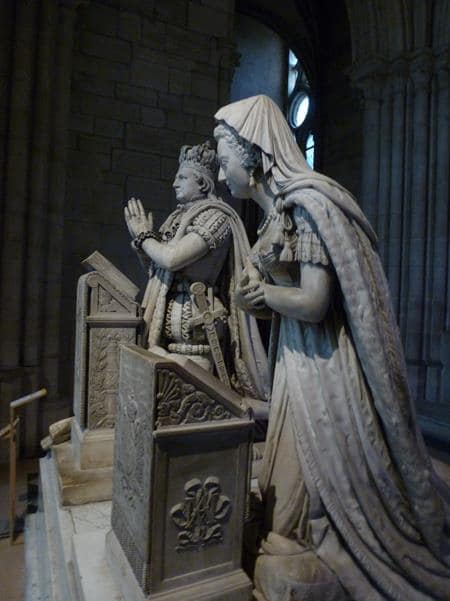
Practical Information
The Basilica is divided into two-parts. Entry into the Basilica itelf is free but the entrance to the Necropolis isn’t. The Basilica is easy to reach by taking the Metro 13 Direction “Saint Denis Université” and stopping at the “Basilique Saint Denis” stop. It is about 30 minutes from the Montparnasse Train-Station. For more information go to http://saint-denis.monuments-nationaux.fr/
You may also be interested in reading Yann’s excellent article on Anne of Brittany – click here
All photos are copyright Yann Kergourlay.